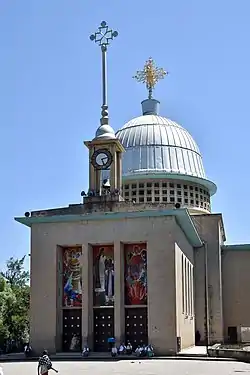
Christian monasticism in Ethiopia has ben practiced since the Aksumite era in the 6th century AD. The Nine Saints from the Byzantine Empire have played crucial roles in the development of monasticism in Ethiopia, which also continued during the Zagwe and Solomonic periods.
Debre Libanos and Debre Damo are some of the best-known monasteries in Ethiopia. Monasteries often have titles of "Debre" and "Gedam" attached to communities of monks and nuns.
Overview
_Entrance.jpg.webp)
As tabots are associated with angels, Ethiopian monks are considered messengers of God that transcends from previous concept of theosis and is interpreted as a form of physical transformation.[1][2] In terms of gender, monks usually represent the larger section in the Ethiopian clergy whose "total number has been estimated at from 10% to 20% of the population, particularly the male population"; men constitute 80% of the monastics in Ethiopia. There are also substantial number of nuns in every monastery. Nuns often do not considerate gender gap by assigning male or female superiority and responded that "God does not distinguish between male and female", and view monastic life as "mimesis of the life of Christ".[3][4]

Monastery of Ethiopia usually are not founded enclosed or fortified structure, but most are in mountainous range through ambas, terrain, or hillside. Examples of such monasteries include Debre Damo, Debre Libanos and monasteries around Lake Tana islands. It is difficult to characterized Ethiopian monasteries from obvious larger "bounded" cenobitic (communal) sites such as Debre Damo and Debre Libanos. In general, Ethiopian church attributed to monastery because they associated with "Debre" or "Gedam" name and attach to community of monks and nuns.[5]
In Addis Ababa, Orthodox Christians endorse media promotion about religion, but are debated how to use correctly of promoting asceticism, humility, and attention to God, but avoided pride.[6]
Historical context
Kingdom of Aksum
Ethiopian monasteries have played vital sociocultural and economic roles within Christian society in the Ethiopian Highlands. The concept of Christian monasticism dates back to Kingdom of Aksum through missionaries called Nine Saints around the sixth century AD. Early Ethiopian monasticism was similar to that of adjacent regions such as Egypt, Nubia and the Levant. As in Egypt, the monastery of Ethiopia unlikely had an active role in the Christianization of the local people.[5]
According to mainstream historical records, Christianity reached to the Axumite Empire during the reign of King Ezana in 330, although traditional accounts different the introduction of Christianity to early Church period. Christianity persisted through the Early Middle Ages and many large church buildings were constructed in northern province of Ethiopia followed by rapid change in material culture (e.g., coinage, funerary tradition).[5]
Christianity also survived through decline of Kingdom of Aksum in the seventh century and continued until the Dark Age, which written records overwhelming from external sources. The fall of Aksum is due to two main reasons: the first is anonymity of its rulers and their size and status due to decentralized structure. The History of the Patriarchs of Alexandria is best example of this reason, and the second one is most accounts came from Arab writers, often travellers and wrote much information about the economic status of the period.[5]
Zagwe dynasty
The Zagwe dynasty, which succeeded the Axumite dynasty, reinvigorated Christendom after founding its capital Roha in the 12th century, and later renamed Lalibela after eponymous king of the same name. During the reign of Gebre Meskel Lalibela, eleven rock-hewn churches were constructed within the town, and churches were also built in caves in the countryside around Lalibela.[5]
However, historical records even in this period became more obscure than Aksum. The Gadlat (hagiographies) was the main source of notable kings and saints' description and are written later than the actual events they describe, although oral history differs with the respect of archeological works at Lalibela.[5]
Solomonic period
Monastery became essence life in social and economic role during the Solomonic period since the ascension of Yekuno Amlak (r. 1270–1285), providing charismatic religious leaders such as Abune Tekle Haymanot (1215–1313) and Iyasus Mo'a (1214–1294). Monasteries attracted royal patronage and became important centers of wealth within the political elite, where secular power was vested in the Emperor of Ethiopia and his court, as well as in the feudal system.[5]
Until the Ethiopian Revolution in 1974, monasticism was important to the economy and agriculture of the highlands area, which utilized the gult system. After the abolition of the monarchy in 1975, monasteries became nationalized during the Derg regime which diminished their power.[5]
References
- ↑ Persoon, Joachim (2007-08-01). "Ethiopian monasticism". International Journal for the Study of the Christian Church. 7 (3): 240–245. doi:10.1080/14742250701550233. ISSN 1474-225X.
- ↑ Lusini, Gianfrancesco (2020-01-08). The Ancient and Medieval History of Eritrean and Ethiopian Monasticism: An Outline. Brill. ISBN 978-90-04-41958-2.
- ↑ Persoon, Joachim (2002). "The Ethiopian monk: a changing concept of masculinity". Journal of Ethiopian Studies. 35 (1): 43–65. ISSN 0304-2243.
- ↑ Persoon, Joachim (2007-08-01). "Ethiopian monasticism". International Journal for the Study of the Christian Church. 7 (3): 240–245. doi:10.1080/14742250701550233. ISSN 1474-225X.
- 1 2 3 4 5 6 7 8 Finneran, Niall (2012). "Hermits, Saints, and Snakes: The Archaeology of the Early Ethiopian Monastery in Wider Context". The International Journal of African Historical Studies. 45 (2): 247–271. ISSN 0361-7882.
- ↑ "Religion as a Problem of Attention: Asceticism and Spectacle in Orthodox Ethiopia". Institute for Religion, Culture and Public Life. Retrieved 2022-08-29.